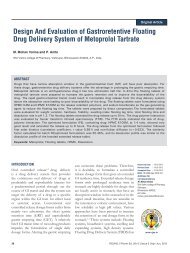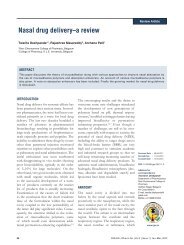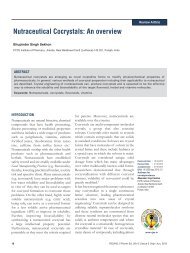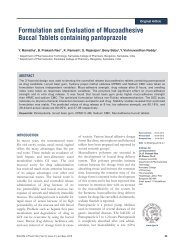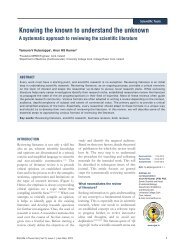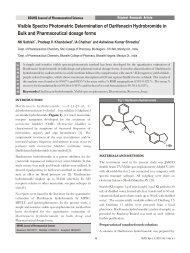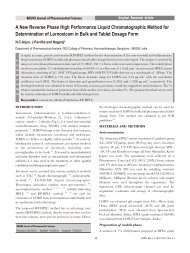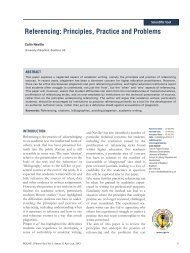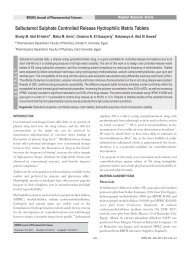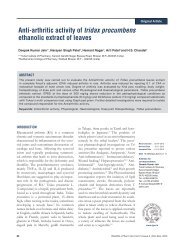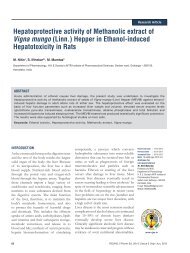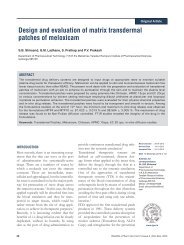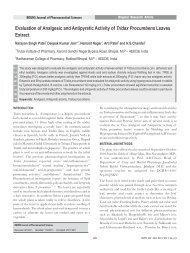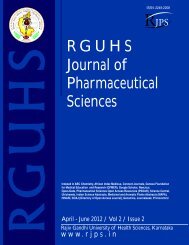Chitosan Loaded Mucoadhesive Microspheres of Gliclazide - Journal
Chitosan Loaded Mucoadhesive Microspheres of Gliclazide - Journal
Chitosan Loaded Mucoadhesive Microspheres of Gliclazide - Journal
Create successful ePaper yourself
Turn your PDF publications into a flip-book with our unique Google optimized e-Paper software.
procured from SD Fine Chem., Mumbai and all other<br />
chemicals used were <strong>of</strong> analytical grade.<br />
Preparation <strong>of</strong> Nebivolol Buccal Films<br />
Nebivolol mucoadhesive buccal films were prepared using<br />
hydroxy propyl methyl cellulose (HPMC) and methyl cellulose<br />
8<br />
(MC) by solvent casting technique .<br />
Accurately weighed quantity <strong>of</strong> hydroxy propyl methyl<br />
cellulose was soaked ethanol (chlor<strong>of</strong>orm and ethanol in the<br />
ratio <strong>of</strong> 75:25 % v/v for methyl cellulose) for 24 hrs, the<br />
calculated amount <strong>of</strong> nebivolol was dissolved in the polymeric<br />
solution and propylene glycol was added gradually with<br />
continuous stirring. 5 ml resultant mixture was poured into<br />
each fabricated glass ring placed on aluminum foil in a petri<br />
dish, and then the petri dish was kept aside for drying at room<br />
temperature for 24 hours. The dried polymeric films were cut<br />
into circular films <strong>of</strong> 10 mm diameter for further evaluation.<br />
Evaluation <strong>of</strong> Nebivolol <strong>Mucoadhesive</strong> Buccal<br />
Films<br />
9<br />
Weight Uniformity<br />
A film <strong>of</strong> 10mm diameter was weighed using Shimadzu<br />
digital balance and the average weight was calculated (n=3).<br />
10<br />
Thickness Uniformity<br />
The thickness <strong>of</strong> the film was measured using screw gauge<br />
with a least count <strong>of</strong> 0.01mm at three different spots <strong>of</strong> the<br />
film and the average thickness was calculated.<br />
11<br />
Folding Endurance<br />
The flexibility <strong>of</strong> film can be measured quantitatively in terms<br />
<strong>of</strong> folding endurance. The folding endurance <strong>of</strong> the film was<br />
determined by repeatedly folding a small strip <strong>of</strong> the films at<br />
the same place till it broke. The number <strong>of</strong> times films could<br />
be folded at the same place without breaking indicated the<br />
value <strong>of</strong> folding endurance and the procedure was repeated<br />
for three times.<br />
12<br />
Swelling Index<br />
A buccal film <strong>of</strong> 10 mm diameter was weighed on a preweighed<br />
cover slip, the initial weight <strong>of</strong> the film was recorded<br />
(W ) and then it was kept in a petri dish containing 5 ml <strong>of</strong><br />
0<br />
phosphate buffer pH 6.8. The cover slip was removed at time<br />
interval <strong>of</strong> 0.5, 1, 2, 3, 4, 5, 6, 7, 8 hr, and excess <strong>of</strong> water was<br />
carefully removed and swollen film was re-weighed (W ). The<br />
t<br />
percentage swelling (%S) was calculated by following formula:<br />
W -W<br />
t o<br />
%S = --------------------- x 100<br />
W o<br />
The mean %S was calculated (n=3).<br />
Bushetti S.S et al./ Development and Evaluation <strong>of</strong> <strong>Mucoadhesive</strong> Buccal Films <strong>of</strong> Nebivolol<br />
158<br />
13<br />
Surface pH<br />
The film was allowed to come in contact with 1ml <strong>of</strong><br />
phosphate buffer pH 6.8 for 1-3 min. The surface pH was<br />
measured using pen pH meter (n=3).<br />
Drug Content Uniformity<br />
This study was carried out to know the complete and uniform<br />
dispersion <strong>of</strong> the drug throughout the film. The film <strong>of</strong> 10 mm<br />
diameter was dissolved in methanol and the absorbance <strong>of</strong> the<br />
14<br />
solution (after suitable dilution) was measured at 282 nm<br />
using UV/visible spectrophotometer (Shimadzu UV-1700).<br />
The percentage drug content was calculated with the help <strong>of</strong><br />
calibration curve (n=3).<br />
In- vitro Drug Release<br />
The drug release from buccal film was studied by standard<br />
cylindrical tube method using sigma dialysis membrane. The<br />
membrane was tied to one end <strong>of</strong> open cylinder and is acted as<br />
donor compartment, the buccal film was placed inside this<br />
compartment and it was in contact with the receptor<br />
compartment containing 100 ml <strong>of</strong> phosphate buffer pH 6.8.<br />
The diffusion medium was stirred continuously using<br />
magnetic stirrer and the temperature was maintained at<br />
37±0.5ºC. 5 ml sample was withdrawn from the receptor<br />
compartment at periodic intervals and the same was replaced<br />
by equal volume <strong>of</strong> fresh buffer solution. The samples were<br />
analyzed for drug content spectrophotometrically at 282 nm.<br />
The amount <strong>of</strong> drug released was calculated with the help <strong>of</strong><br />
standard calibration curve and cumulative percentage drug<br />
release was calculated. In-vitro release data were subjected to<br />
release kinetic equations and were plotted for various graphs.<br />
15<br />
Ex vivo <strong>Mucoadhesive</strong> Strength<br />
Sheep buccal mucosa was obtained from a local<br />
slaughterhouse; the mucosal membrane was separated by<br />
removing the underlining fat and loose tissues. The<br />
membrane was washed with distilled water and subsequently<br />
with isotonic phosphate buffer (IPB) solution <strong>of</strong> 6.8 pH at<br />
0<br />
37 C. The bioadhesive strength <strong>of</strong> the film was measured on<br />
modified physical balance.<br />
15<br />
In vitro Residence Time<br />
The in-vitro residence time was determined using a locally<br />
modified USP disintegration test apparatus. A segment <strong>of</strong><br />
sheep buccal mucosa <strong>of</strong> 3 cm long was glued to the surface <strong>of</strong><br />
a glass slab, vertically attached to the apparatus. The<br />
mucoadhesive films were hydrated from one surface using 15<br />
µl IPB and then the hydrated surface was brought into contact<br />
with the mucosal membrane. The glass slab was vertically<br />
fixed to the apparatus and allowed to move up and down in<br />
0<br />
800 ml IPB maintained at 37 C, so that the film was<br />
completely immersed in the buffer solution at the lowest point<br />
RJPS, Jul - Sep, 2011/ Vol 1/ Issue 2



